Revenge of the Librarians by Tom Gauld [Graphic Novel]
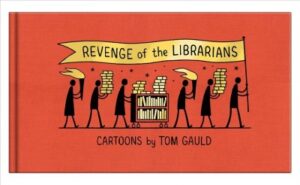
view/request
This book will tickle the funny bone of readers and writers alike.


view/request
This book will tickle the funny bone of readers and writers alike.
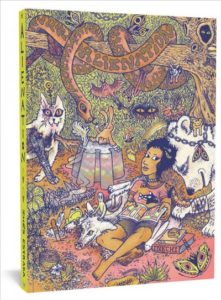
view/request
Alienation is a cinematic and upsetting vision of humanity’s immediate future after climate collapse. In this sci-fi body horror, the colonizers and capitalists of today own the biotechnology that allows Eliza and Carlos to all but exist physically in a vast virtual world. The so-called non playable characters of this virtual reality seem to be evolving past artificial intelligence. Estrada’s monochrome illustrations, beautiful and appropriately mind-bending, feel like the perfect means to explore body sovereignty in a world where technology is created by and for those in power.
A cautionary and escapist tale.
Tagged: Comics, Fiction, Horror, Science fiction
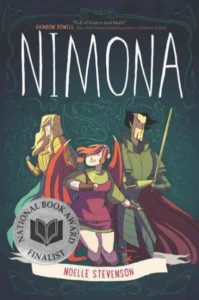
view/request
Ballister Blackheart, a kind-hearted supervillain, gains a new sidekick when Nimona, a shapeshifter in the (sometimes) shape of a young girl, simply insists. Nimona seems to be interested only in mischief, villainy and fun. Blackheart has little patience for her antics but they learn to get along and become a family of sorts, and a team that may just be capable of bringing down The Institution. Blackheart and Nimona each have their own rules, though, and their own complicated pasts.
Noelle Stevenson’s graphic novel, first released as a webcomic, is a delightful read. The artwork is inviting with simple expressive lines, and beautiful colorwork in a subdued palate. Nimona can be a mouse or a lion, a boy or a girl, a squirrel or a dragon. This makes for a very fun to read comic, as we learn to recognize Nimona in her many forms, and of course Nimona’s shape shifting comes in handy in the pair’s many schemes. The story is touching and humorous, though it’s the characters that keep you turning the pages. If you are anything like me you will finish wanting more.
Tagged: Fantasy
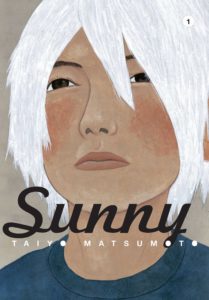
view/request
Eisner award winner Taiyo Matsumoto’s semi-autobiographical account of the Star Kids orphanage is hands down the greatest unsung hero of contemporary manga currently being published. Why this book has not shown up on more “Best Of” and “Required Reading” lists is a puzzle, and I can only hope that this small dispatch might somehow get these books into more hands. The 6 volumes of Sunny (5 currently available – part 6 to be published any day now!) follow the day to day happenings at the Star Kids home – with each chapter showcasing one of the disparate, displaced children and their caretakers. These are mostly simple stories: the new kid tries to settle into his new home, dinner time arguments about what to watch on t.v., the fallout from a white lie about a cup… but what makes them special is Matsumoto’s ability through his poetic mastery of the language of comics to instill something stronger than empathy – the reader is actually transported into the hazy logic of youth through the combination of pictures and words.
The following chapter titles, one from each volume, hint at the simple majesty at work:
Chapter 2: “Why’re Dracula’s fingernails so long?” “‘Cause he doesn’t cut ’em.”
Chapter 12: “The city always seems angry.” “Like it’s shoutin’ ‘HEY!’ or somethin’?”
Chapter 17: “If I had my own department store, I’d make every floor for toys.” “That’s just a big toy store.”
Chapter 24: “Auoooh.” “Waaaaa.”
Chapter 29: “You think a rainbow’s hot if you touch it?” “The blue part’s gotta be cold.”
These slice of life vignettes somehow manage to capture the elusive feelings and perspective of a child – treating all of their melancholy and frustration, as well as their elation, with an uncanny sympathetic tone – all through his evocative illustration style combining scratchy pen with spots of ink wash. The ambivalence of a runny nose, the proprietary daydream space of a broken down car (a Nissan Sunny 1200, for which the series takes its name), and the powerfully charged relic of a mother’s hand salve tin are all presented with what could only be considered magic. At some moment while reading (possibly during a characters’ first foray into shoplifting, or while everyone is scurrying to get out of an oncoming storm), through some sort of literary sleight of hand you’ll realize your heart has just been inextricably joined to the Star Kids’ lives and will potentially need some mending when you flip closed the last page.
Beautifully designed and printed as part of Viz’s Signature Editions, these small hardcovers are given the proper presentation to contain the deeply affecting stories held within.

Tagged: Coming-of-age, Families, Fiction, Friendship
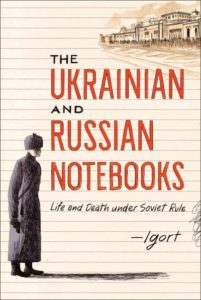
view/request
New graphic nonfiction by Italian comics artist Igort!
Over the past few decades only a small handful of Igort’s work have been translated into English, despite his status as an award winning graphic novelist and the founder of esteemed publishing house Coconino Press, so a new arrival of his to our shores is always a reason for excitement.
For his newest graphic novel Igort spent two years in Ukraine and Russia collecting stories from survivors and witnesses of life under Soviet rule. Focusing on the government sanctioned famine of 1932, and the assassination in 2006 of journalist and human rights activist Anna Politkovskaya, this collection of deeply affecting interviews is rendered in Igort’s stark yet compassionate illustrative style. A single opening panel just telling the year can pack as much emotion and connotative information as some other artist’s entire novels, simply through his layering of images and line work — a true master of the craft.
Definitely not an easy read in terms of its direct depictions of human atrocities, but certainly one of the most important graphic novels of the year, humanizing events that have mostly been told through a skewed western lens, while also connecting current turmoil in the region to its tumultuous past, helping create a more complete and honest history.
Tagged: Comics, Graphic nonfiction, History

view/request
Memories of being hidden, and keeping those memories hidden… A grandmother tells a special story from her childhood in this touching graphic novel about being young during World War II.
Douina’s lives with her mother and father in Paris. Her life is relatively normal until she is made to wear a star on her jacket. Her father had told her it was a sheriff’s star but everyone begins to treat her differently. Soon her parents are taken away to work camps and Douina is left to be cared for by neighbors and kind strangers. As she settles into her new life and new name, Simone, she can’t help but miss her mother and father. Once the war has ended and it is safe again, she travels back home and begins the search for her parents.
This book offers children a glimpse into the past- what it was like to be young during WWII and how some children and families were affected by the Holocaust in France. Words by Loïc Dauvillier and art by Marc Lizano and Greg Salsedo
Tagged: Families, History, Memoir, World War II

view/request
Writer/illustrator Michael Kupperman drums up a thrilling, hilarious tale of what happened after Mark Twain had staged his death in 1910. Mark Twain is immortal. Wait, you didn’t know that?
Illustrations and short accompanying text highlight a century of the famed author’s mischief making. Kupperman obviously takes several liberties and also writes Twain a little crankier and crass than we’re used to reading, but he still manages to effectively live within the author’s witty voice. Twain’s stint as a shock jock radio host, experiments with psychedelics, space travel, advice to Charles Shultz, a psychic altercation with a doughnut shop employee (see below) and general shenanigans with his buddy Albert Einstein are just some of the episodes of this adventure.
Tagged: Fiction

view/request
Moyna Chitrakar is an artist from the Patua scroll painting tradition. The paintings in this book have been adapted fit the page, but they are rendered in a style that wasn’t meant to be confined to such a small space—Patua scrolls are large and complex. Significantly, the Patua artist traditionally tells the story through song while unrolling the scroll and gesturing to images. Keep this in mind as you read Sita’s Ramayana. The images sometimes feel cramped on the page, and the juxtaposition between text and image is often awkward, but remembering the traditional manner of presenting these paintings will help you see past these small annoyances to appreciate the elgeance of Chitrakar’s art.
Sita’s Ramayana presents the Hindu epic the Ramayana from the perspective of Rama’s wife, Sita. In this version Rama’s noble character is taken as a given—even when Sita suffers as a result of Rama’s actions her love for him does not falter. Samhita Arni’s Sita does not tell us why she loves Rama. Instead she tells what happened, and how she felt about it. She tells us about her doubts and fears, and about the suffering she saw on both sides as Rama’s army made war on Lanka.
Sita’s Ramayana‘s is a quick retelling of the Ramayana, and differs from the classic version in ways that may make you eager to explore this famous story’s many variations. Moyna Chitrakar’s art is beautiful, and while more care might have been taken in the page design, lovers of traditional art and myth will find something to appreciate in this book.
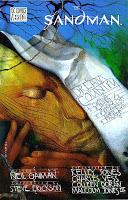
view/request
Ten years ago a friend lent me The Sandman: Brief Lives. I had not read many comics, but I was hooked, and I quickly read each of the ten trade paperbacks that make up The Sandman. (Brief Lives is actually the seventh volume in the series, but it was a good place to start, as it better reflects the character of the series as a whole than does the dark and brooding Preludes and Nocturnes. If you know you are going to read the whole series, start at the beginning, but if you are unsure, starting with Brief Lives is not a bad idea.)
Although nominally set in the universe of DC Comics, no past comic reading experience is required. More important is a knowledge of myth and literature, and an appreciation for story and fantasy. The Sandman is a collection of stories which together tell the story of Dream. Dream, in The Sandman, is both a character, and a fundamental, inescapable force of the universe in which he resides. He is one of the Endless, and like Destiny, Death, Destruction, Despair, Desire and Delirium, he has always been, and will always be. Despite this, Dream is moody, stubborn, and often remarkably human.
The Sandman had its roots in horror, a genre I have never had much inclination to explore, but while it has fantastical and grotesque elements, it is too optimistic, too affirming, too delightful to be anything of the kind. The characters of Death and Delirium are particularly delightful—while both have their obvious dark sides they are depicted as being kind and caring; Death in particular is shown to be particularly wise. Most of all we delight in the world of stories and dreams. “The Dreaming”, where Dream makes his home, also provides its own delights, including a cast of often comic characters and a library containing every book and every story.
Many different artists worked with Neil Gaiman on The Sandman, and the art is always competent, and often very good indeed, especially in the later volumes. I’m particularly fond of some of P. Craig Russell and Jill Thompson’s illustrations, and Dave McKean’s covers are fantastic.
The Sandman is a haunting story with great characters set in a complex, detailed world. It is made up of many stories of many different types, and its variety is part of its appeal. This is a great graphic novel, and worth trying even if you aren’t normally a fan of comics.
Tagged: Fantasy
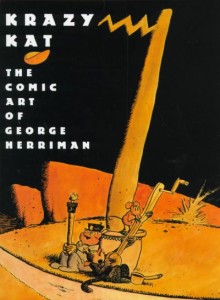
view/request
Krazy Kat was a remarkable and hugely influential daily comic. Found in newspapers around the country for over 30 years, from 1913 and 1944, it would influence comics greats such as Charles M. Schulz, Will Eisner, and Bill Watterson. Krazy Kat: The Comic Art of George Herriman provides an overview of the life and works of Krazy Kat creator George Herriman, and includes a large collection of beautifully reproduced daily and Sunday Krazy Kat strips.
Herriman’s astonishing Sunday Krazy Kats are reason to pick up this book alone. Giant, free form, brightly colored affairs, unconstrained by the rigid panels of today’s strips, it is the surreal landscapes and innovative design of the Sunday strips for which Herriman is best know, and with good reason. (Fans of Calvin and Hobbes will immediately recognize the influence of these strips on Bill Waterson’s Spaceman Spiff strips.)
Krazy Kat is not particularly funny, but I love reading it. Krazy Kat is dreamlike and poetic, a little bit difficult, and very much worth your while. Full of characters and images you will not forget, this is a bit of comics history you should definitely check out.
Tagged: Comics, Non-fiction

view/request
I.N.J Culbard illustrates Ian Edginton’s adaption of Sir Arthur Conan Doyle’s The Sign of Four. This graphic novel takes on the second Sherlock Holmes story in which the famed detective and Doctor Watson must locate a mysterious stolen treasure. Holmes applies his trademark acute deductive reasoning skills while sprinkling in impatient and acerbic comments to all those within an earshot.
Being a longtime admirer of Doyle’s Sherlock Holmes stories, seeing the tale presented as a graphic novel is a quite a treat.

view/request
French Milk is a travelogue, photo journal and graphic novel rolled into one deliciously exciting book. Lucy Knisley illustrates and writes about six-week stay she and her mother had in Paris in 2007. Sightseeing, love interests, her parents and baguettes are all discussed with a great deal of candidness and humor.
Tagged: France, Non-fiction, Travel